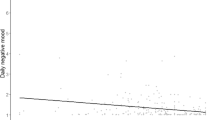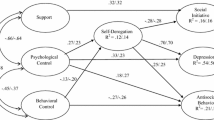Abstract
Using symbolic interaction, we developed a research model that proposed adolescent perceptions of parental support and psychological control would be related to adolescent depressed mood directly and indirectly through self-esteem. We tested the model using self-report questionnaire data from 161 adolescents living with both of their biological parents. To examine possible gender of adolescent differences, we tested two multigroup models separately for adolescents’ perceptions of mothers’ and fathers’ parental behaviors. Both the fathers’ and mothers’ models yielded (a) direct paths from self-esteem to depressed mood (for boys and girls), psychological control to depressed mood (for boys) and (b) an indirect path from support to self-esteem to depressed mood (for girls and boys) and an indirect path from psychological control to self-esteem to depressed mood (for girls). In addition, in the fathers’ model a significant direct path was found between fathers’ support and depressed mood (for girls).


Similar content being viewed by others
References
Abramson, L. Y., Metalsky, G. I., & Alloy, L. B. (1989). Hopelessness depression: A theory-based subtype of depression. Psychological Review, 96, 358–372.
Angold, A., Costello, E. J., & Erkanli, A. (1999). Comorbidity. Journal of Child Psychology and Psychiatry, 40, 57–87.
Barber, B. K. (1996). Parental psychological control: Revisiting a neglected construct. Child Development, 67, 3296–3319.
Barber, B. K. (1996). Parental psychological control: Revisiting a neglected construct. Child Development, 67, 3296–3319.
Barber, B. K., & Harmon, E. L. (2002). Violating the self: Parental psychological control of children and adolescents. In B. K. Barber (Ed.), Intrusive parenting: How psychological control affects children and adolescents (pp. 15–52). Washington, DC: American Psychological Association.
Barber, B. K., Stolz, H. E., & Olsen, J. A. (2005). Parental support, psychological control, and behavioral control: Assessing relevance across time, culture, and method. Monographs of the Society for Research in Child Development, 70(4), 1–137.
Beck, A. T. (1967). Depression: Clinical, experimental, and theoretical aspects. New York, Harper & Row.
Beck, A. T. (1974). The development of depression: A cognitive model. In R. J. Friedman & M. M. Katz (Eds.), The psychology of depression: Contemporary theory and research (pp. 3–28). New York: Wiley.
Beck, A. T., & Beck, R. W. (1972). Screening depressed patients in family practice: A rapid technique. Post Graduate Medicine, 52, 81–85.
Bentler, P. M. (1990). Comparative fit indexes in structural models. Psychological Bulletin, 107, 238–246.
Bogard, K. L. (2005). Affluent adolescents, depression, and drug use: The role of adults in their lives. Adolescence, 40, 281–306.
Burr, W. R., Leigh, G. K., Day, R. D., & Constantine, J. (1979). Symbolic interaction and the family. In W. R. Burr, R. Hill, F. I. Nye, & I. L. Reiss (Eds.), Contemporary theories about the family (Vol. 2, pp. 42–111). New York: Free Press.
Butler, A. C., Chapman, J. E., Forman, E. M., & Beck, A. T. (2006). The empirical status of cognitive-behavioral therapy: A review of meta-analyses. Clinical Psychology Review, 26, 17–31.
Compas, B., Ey, S., & Grant, K. (1993). Taxonomy, assessment, and diagnosis of depression during adolescence. Psychological Bulletin, 101, 393–403.
Conger, K., Conger, R. D., & Scaramella, L. V. (1997). Parents, siblings, psychological control, and adolescent adjustment. Journal of Adolescent Research, 12, 113–138.
Cooley, C. H. (1902). Human nature and the social order. New York: Scribner’s.
Costello, E. J., Mustillo, S., Erkanli, A., Keeler, G., & Angold, A. (2003). Prevalence and development of psychiatric disorders in childhood and adolescence. Archives of General Psychiatry, 60, 837–844.
Craighead, L. W., & Green, B. J. (1989). Relationship between depressed mood and sex-typed personality characteristics in adolescents. Journal of Youth and Adolescence, 18, 467–474.
Crick, N. R., & Zahn-Waxler, C. (2003). The development of psychopathology in females and males: Current progress and future challenges. Development and Psychopathology, 15, 719–742.
Crook, T., Raskin, A., & Eliot, J. (1981). Parent-child relationships and adult depression. Child Development, 52, 950–957.
Demo, D. H., Small, S. A., & Savin-Williams, R. C. (1987). Family relations and the self-esteem of adolescents and their parents. Journal of Marriage and the Family, 49, 705–715.
Dumont, M., & Provost, M. A. (1999). Resilience in adolescents: Protective role of social support, coping strategies, self-esteem, and social activities on experience of stress and depression. Journal of Youth and Adolescence, 28, 343–363.
Field, T., Diego, M., & Sanders, C. (2001). Adolescent depression and risk factors. Adolescence, 36, 491–498.
Garber, J., Robinson, N. S., & Valentiner, D. (1997). The relation between parenting and adolescent depression: Self-worth as a mediator. Journal of Adolescent Research, 12, 12–33.
Ge, X., Best, K., Conger, R. D., & Simons, R. L. (1996). Parenting behaviors and the occurrence and co-occurrence of adolescent depressive symptoms and conduct problems. Developmental Psychology, 32, 717–731.
Hankin, B. L., Abramson, L. Y., Moffitt, T. E., Angell, K. E., Silva, P. A., & McGee, R. (1998). Development of depression from preadolescence to young adulthood: Emerging gender differences in a 10-year longitudinal study. Journal of Abnormal Psychology, 107(1), 128–140.
Harter, S. (1990). Causes, correlates, and the functional role of global self-worth: A lifetime perspective. In R. J. Sternberg & J. Kolligian, Jr. (Eds.), Competence considered (pp. 67–97). New Haven, CT: Yale University Press.
Holden, G. W., & Miller, P. C. (1999). Enduring and different: A metaanalysis of the similarity in parents’ child rearing. Psychological Bulletin, 125, 223–254.
Hollis, C. (1996). Depression, family environment, and adolescent suicidal behavior. Journal of the American Academy of Child and Adolescent Psychiatry, 35, 622–630.
Jenkins, S. R., Goodness, K., & Buhrmester, D. (2002). Gender differences in early adolescents’ relationship qualities, self-efficacy, and depression symptoms. Journal of Early Adolescence, 22, 277–309.
Jöreskog, K., & Sörbom, D. (2004). LISREL 8.72 [Software]. Chicago: Scientific Software International.
Kaslow, N. J., Deering, C. G., & Racusin, G. R. (1994). Depressed children and their families. Clinical Psychology Review, 14, 39–59.
Katainen, S., Raeikkoenen, K., Keskivaara, P., & Keltikangas-Jaervinen, L. (1999). Maternal child-rearing attitudes and role satisfaction and children’s temperament as antecedents of adolescent depressive tendencies: Follow-up study of 6- to 15-year-olds. Journal of Youth and Adolescence, 28, 139–163.
Kling, K. C., Hyde, J. S., Showers, C. J., & Buswell, B. N. (1999). Gender differences in self-esteem: A meta-analysis. Psychological Bulletin, 123, 470–500.
Leary, M. R., & Baumeister, R. F. (2000). The nature and function of self-esteem: Sociometer theory. In M. P. Zanna. (Ed.), Advances in experimental social psychology (Vol. 32, pp. 1–62). San Diego, CA: Academic Press.
Lewinsohn, P. M., Rohde, P., Klein, D. N., & Seeley, J. R. (1999). Natural course of adolescent major depressive disorder: 1. Continuity into young adulthood. Journal of the American Academy of Child and Adolescent Psychiatry, 38, 56–63.
Lewinsohn, P. M., Rohde, P., & Seeley, J. R. (1998). Major depressive disorder in older adolescents: Prevalence, risk factors, and clinical implications. Clinical Psychology Review, 18, 765–794.
Mead, G. H. (1934). Mind, self and society. Chicago: University of Chicago Press.
Meadows, S. O., Brown, J. S., & Elder, G. H., Jr. (2006). Depressive symptoms, stress, and support: Gendered trajectories from adolescence to young adulthood. Journal of Youth and Adolescence, 35, 93–103.
Muris, P., Meesters, C., Schouten, E., & Hoge, E. (2004). Effects of perceived control on the relationship between perceived parental rearing behaviors and symptoms of anxiety and depression in nonclincical preadolescents. Journal of Youth and Adolescence, 33, 51–58.
Nolen-Hoeksma, S., & Girgus, J. S. (1994). The emergence of gender differences in depression during adolescence. Psychological Bulletin, 115, 424–443.
Openshaw, D. K., & Thomas, D. L. (1990). The adolescent self and the family. In G. K. Leigh & G. W. Peterson (Eds.), Adolescents in families (pp. 104–129). Cincinnati, OH: South-Western.
Peterson, A. C., Compas, B. E., Brooks-Gunn, J., Stemmler, M., Ey, S., & Grant, K. E. (1993). Depression in adolescence. American Psychologist, 48, 155–168.
Peterson, G. W. (1982). Parental behavior measure. Unpublished manuscript. Knoxville, TN: The University of Tennessee, Department of Child and Family Studies.
Pettit, G. S., Laird, R. D., Dodge, K. A., Bates, J. E., & Criss, M. M. (2001). Antecedents and behavior-problem outcomes of parental monitoring and psychological control in early adolescence. Child Development, 72, 583–598.
Pine, D. S., Cohen, P., Gurley, D., Brook, J., & Ma, Y. (1998). The risk for early-adulthood anxiety and depressive disorders in adolescents with anxiety and depressive disorders. Archives of General Psychiatry, 55, 56–64.
Puig-Antich, J., Lukens, E., Davies, M., Goetz, D., Brennan-Quattrock, J., & Todak, G. (1985a). Psychosocial functioning in pre-pubertal major depressive disorders: I. Interpersonal relationships during the depressive episode. Archives of General Psychiatry, 42, 500–507.
Puig-Antich, J., Lukens, E., Davies, M., Goetz, D., Brennan-Quattrock, J., & Todak, G. (1985b). Psychosocial functioning in pre-pubertal major depressive disorders: II. Interpersonal relationships after sustained recovery from affective episode. Archives of General Psychiatry, 42, 511–517.
Rao, U., Hammen, C., & Daley, S. E. (1999). Continuity of depression during the transition to adulthood: A 5-year longitudinal study of young women. Journal of the American Academy of Child and Adolescent Psychiatry, 38, 908–915.
Robertson, J. F., & Simons, R. L. (1989). Family factors, self-esteem, and adolescent depression. Journal of Marriage and the Family, 51, 125–138.
Rose, A. J., & Rudolph, K. D. (2006). A review of sex differences in peer relationship processes: Potential trade-offs for the emotional and behavior development of girls and boys. Pyschological Bulletin, 132, 98–131.
Rosenberg, M. (1979). Conceiving the self. New York: Basic Books.
Rosenberg, M., Schooler, C., Schoenbach, C., & Rosenberg, F. (1995). Global self-esteem and specific self-esteem: Different concepts, different outcomes. American Sociological Review, 60, 141–156.
Rutter, M., Caspi, A., & Moos, R. H. (2003). Using sex differences in psychopathology to study causal mechanisms: Unifying issues and research strategies. Journal of Child Psychology and Psychiatry and Allied Disciplines, 44, 1092–1115.
Sheeber, L., Hops, H., Alpert, A., Davis, B., & Andrews, J. (1997). Family support and conflict: Prospective relations to adolescent depression. Journal of Abnormal Child Psychology, 25, 333–344.
Sheeber, L., Hyman, H., & Davis, B. (2001). Family processes in adolescent depression. Clinical Child and Family Psychology Review, 4, 19–35.
Speier, P. L., Sherak, D. L., Hirsch, S., & Cantwell, D. P. (1995). Depression in children and adolescents. Handbook of depression (2nd ed., pp. 467–493). New York: Guilford Press.
Thomas, W. I. (1928). The child in America. New York: A. A. Knopf.
Weissman, M. M., Wolk, S., Wichamarante, P., Goldstein, R. B., Adams, P., Greenwald, S., Ryan, N. D., Dahl, R. E., & Steinberg, D. (1999). Children with pre-pubertal-onset major depressive disorder and anxiety grown up. Archives of General Psychiatry, 56, 794–801.
Weisz, J. R., McCarty, C. A., & Valeri, S. M. (2006). Effects of psychotherapy for depression in children and adolescents: A meta-analysis. Psychological Bulletin, 132, 132–149.
Author information
Authors and Affiliations
Corresponding author
Rights and permissions
About this article
Cite this article
Plunkett, S.W., Henry, C.S., Robinson, L.C. et al. Adolescent Perceptions of Parental Behaviors, Adolescent Self-Esteem, and Adolescent Depressed Mood. J Child Fam Stud 16, 760–772 (2007). https://doi.org/10.1007/s10826-006-9123-0
Published:
Issue Date:
DOI: https://doi.org/10.1007/s10826-006-9123-0




